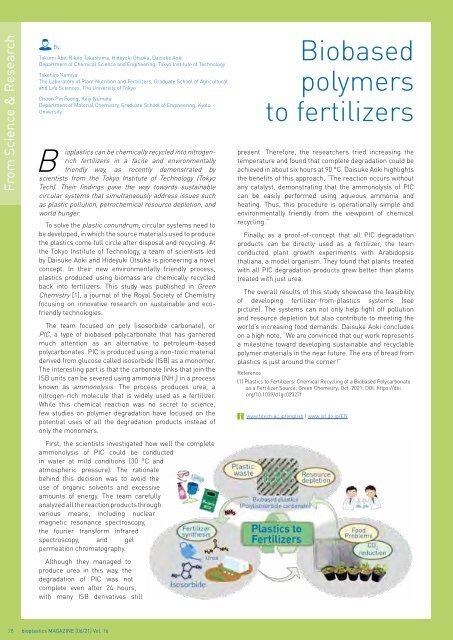Issue 06/2021
Highlights: Coating Films, Flexibles, Bags Basics: Cellulose based bioplastics
Highlights:
Coating
Films, Flexibles, Bags
Basics: Cellulose based bioplastics
Create successful ePaper yourself
Turn your PDF publications into a flip-book with our unique Google optimized e-Paper software.
From Science & Research<br />
By:<br />
Takumi Abe, Rikito Takashima, Hideyuki Otsuka, Daisuke Aoki<br />
Department of Chemical Science and Engineering, Tokyo Institute of Technology<br />
Takehiro Kamiya<br />
The Laboratory of Plant Nutrition and Fertilizers, Graduate School of Agricultural<br />
and Life Sciences, The University of Tokyo<br />
Choon Pin Foong, Keiji Numata<br />
Department of Material Chemistry, Graduate School of Engineering, Kyoto<br />
University<br />
B<br />
ioplastics can be chemically recycled into nitrogenrich<br />
fertilizers in a facile and environmentally<br />
friendly way, as recently demonstrated by<br />
scientists from the Tokyo Institute of Technology (Tokyo<br />
Tech). Their findings pave the way towards sustainable<br />
circular systems that simultaneously address issues such<br />
as plastic pollution, petrochemical resource depletion, and<br />
world hunger.<br />
To solve the plastic conundrum, circular systems need to<br />
be developed, in which the source materials used to produce<br />
the plastics come full circle after disposal and recycling. At<br />
the Tokyo Institute of Technology, a team of scientists led<br />
by Daisuke Aoki and Hideyuki Otsuka is pioneering a novel<br />
concept. In their new environmentally friendly process,<br />
plastics produced using biomass are chemically recycled<br />
back into fertilizers. This study was published in Green<br />
Chemistry [1], a journal of the Royal Society of Chemistry<br />
focusing on innovative research on sustainable and ecofriendly<br />
technologies.<br />
The team focused on poly (isosorbide carbonate), or<br />
PIC, a type of biobased polycarbonate that has garnered<br />
much attention as an alternative to petroleum-based<br />
polycarbonates. PIC is produced using a non-toxic material<br />
derived from glucose called isosorbide (ISB) as a monomer.<br />
The interesting part is that the carbonate links that join the<br />
ISB units can be severed using ammonia (NH 3<br />
) in a process<br />
known as ammonolysis. The process produces urea, a<br />
nitrogen-rich molecule that is widely used as a fertilizer.<br />
While this chemical reaction was no secret to science,<br />
few studies on polymer degradation have focused on the<br />
potential uses of all the degradation products instead of<br />
only the monomers.<br />
First, the scientists investigated how well the complete<br />
ammonolysis of PIC could be conducted<br />
in water at mild conditions (30 °C and<br />
atmospheric pressure). The rationale<br />
behind this decision was to avoid the<br />
use of organic solvents and excessive<br />
amounts of energy. The team carefully<br />
analyzed all the reaction products through<br />
various means, including nuclear<br />
magnetic resonance spectroscopy,<br />
the fourier transform infrared<br />
spectroscopy, and gel<br />
permeation chromatography.<br />
Although they managed to<br />
produce urea in this way, the<br />
degradation of PIC was not<br />
complete even after 24 hours,<br />
with many ISB derivatives still<br />
Biobased<br />
polymers<br />
to fertilizers<br />
present. Therefore, the researchers tried increasing the<br />
temperature and found that complete degradation could be<br />
achieved in about six hours at 90 °C. Daisuke Aoki highlights<br />
the benefits of this approach, “The reaction occurs without<br />
any catalyst, demonstrating that the ammonolysis of PIC<br />
can be easily performed using aqueous ammonia and<br />
heating. Thus, this procedure is operationally simple and<br />
environmentally friendly from the viewpoint of chemical<br />
recycling.”<br />
Finally, as a proof-of-concept that all PIC degradation<br />
products can be directly used as a fertilizer, the team<br />
conducted plant growth experiments with Arabidopsis<br />
thaliana, a model organism. They found that plants treated<br />
with all PIC degradation products grew better than plants<br />
treated with just urea.<br />
The overall results of this study showcase the feasibility<br />
of developing fertilizer-from-plastics systems (see<br />
picture). The systems can not only help fight off pollution<br />
and resource depletion but also contribute to meeting the<br />
world’s increasing food demands. Daisuke Aoki concludes<br />
on a high note, “We are convinced that our work represents<br />
a milestone toward developing sustainable and recyclable<br />
polymer materials in the near future. The era of bread from<br />
plastics is just around the corner!”<br />
Reference<br />
[1] Plastics to Fertilizers: Chemical Recycling of a Biobased Polycarbonate<br />
as a Fertilizer Source; Green Chemistry; Oct. <strong>2021</strong>; DOI: https://doi.<br />
org/10.1039/d1gc02327f<br />
www.titech.ac.jp/english | www.jst.go.jp/EN<br />
28 bioplastics MAGAZINE [<strong>06</strong>/21] Vol. 16

















